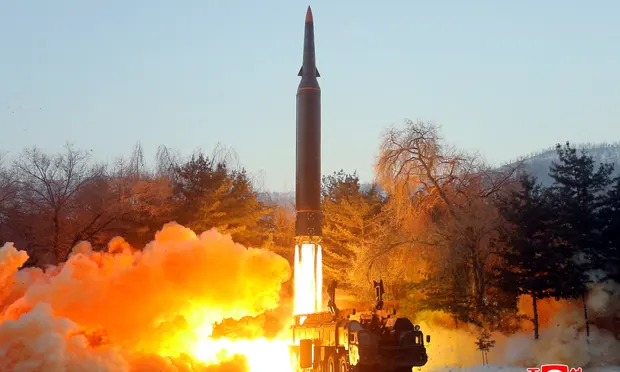North Korea has test-fired a suspected ballistic missile that may be an improved version of a “hypersonic missile” it launched only last week, in a move designed to increase pressure on the US amid stalled nuclear talks and mounting economic problems for the regime.
Tuesday’s launch was detected at 7.27am on Tuesday from an inland area of North Korea toward the ocean off its east coast, South Korea’s joint chiefs of staff (JCS) said in a statement.
The missile travelled more than 700km (435 miles) to a maximum altitude of 60km (37 miles), according to initial estimates, and at a top speed of Mach 10, or 10 times the speed of sound, the JCS added.
“We assess that this is more advanced than the missile North Korea fired on 5 January,” it said, adding that South Korean and US intelligence authorities were conducting a detailed analysis.
The projectile appeared to have landed outside Japan’s exclusive economic zone (EEZ), the Kyodo news agency reported, citing government sources in Tokyo.
The launch drew immediate condemnation from Japan. “That North Korea continues to launch missiles is extremely regrettable,” the prime minister, Fumio Kishida, said.
South Korea’s national security council expressed “strong regret” that the missile test had come at a time of fragile regional stability, and urged North Korea to resume dialogue and cooperation, the presidential Blue House said in a statement.
The launch came soon after the United Nations ended discussions on how to respond to last week’s test of what North Korea claimed was a “hypersonic missile”, which fly at least five times the speed of sound and at relatively low trajectories, making them harder to detect and intercept.
A second hypersonic test, coming so soon after last week’s, could indicate that the earlier launch had failed, said Kim Dong-yub, a professor at the University of North Korean Studies. “It’s hard to understand why they would carry out another test less than a week after they announced a success,” he said.
By testing two missiles already this year, North Korea appears to be following up on a recent call from its leader, Kim Jong-un, to bolster the military to counter an unstable international situation amid stalled denuclearisation talks with the US.
Pyongyang has traditionally used missile and nuclear tests to prove its ability to develop its weapons technology despite years of international sanctions, and to raise pressure on the US and South Korea to make concessions ahead of any future negotiations.
But nuclear talks that would give the North the opportunity to seek economic aid and security guarantees from Washington have not been held since 2019, when a second summit between Kim and Donald Trump ended prematurely after they failed to agree on sanctions relief in return for moves to partially dismantle Pyongyang’s nuclear arsenal.
The Biden administration has said it is open to talks “without preconditions”, but insists it will not abandon its goal of denuclearisation. North Korea has said it is also ready to negotiate, but only if the US and other countries drop their “hostile policies” – a presumed reference to sanctions and joint military drills.
“Even with North Korea’s pandemic border lockdowns restricting trade and diplomacy, Pyongyang is determined to run an arms race against Seoul and deny Washington the luxury of focusing on Russia and China,” said Leif-Eric Easley, a professor at Ewha University in Seoul.
Shin Beom-chul, a researcher at the Korea Research Institute for National Strategy, said Pyongyang might have timed the latest launch to coincide with a UN security council meeting where the US, along with France, Ireland, Japan, Britain and Albania issued a joint statement condemning last week’s “hypersonic” test.
“The launch has political and military motives,” Shin said. “North Korea continues testing to diversify its nuclear arsenal, but it timed the launch on the day of the UNSC meeting to maximise its political impact.”
The US ambassador to the UN, Linda Thomas-Greenfield, said in Monday’s statement that the North’s missile tests “increase the risk of miscalculation and escalation and pose a significant threat to regional stability”.
Some analysts believe Kim has used missile tests as a distraction as he attempts to address serious domestic problems, including food shortages and economic damage stemming from a slump in cross-border trade with China during the coronavirus pandemic.
The Yonhap news agency said this week that South Korea’s unification ministry was closely monitoring a possible shift in the North’s anti-coronavirus measures, including the easing of border restrictions and less reliance on strict controls on people’s movements, following a report in the state-controlled Rodong Sinmun newspaper.
“We need to move to a better advanced, people-oriented epidemic work from one that focused on control measures,” Yonhap quoted the newspaper as saying.
Thomas-Greenfield reiterated calls for countries to enforce sanctions, and for North Korea to return to talks and abandon its missiles and nuclear weapons.
South Korean military officials have cast doubts on the capabilities of the “hypersonic missile” North Korea claimed to have test-fired on Wednesday, saying it appeared to represent limited progress beyond Pyongyang’s existing ballistic missile technology.
UN security council resolutions ban all ballistic missile and nuclear tests by North Korea, and have imposed sanctions over the programmes. But few observers expect Kim to fully surrender his nuclear arsenal.
